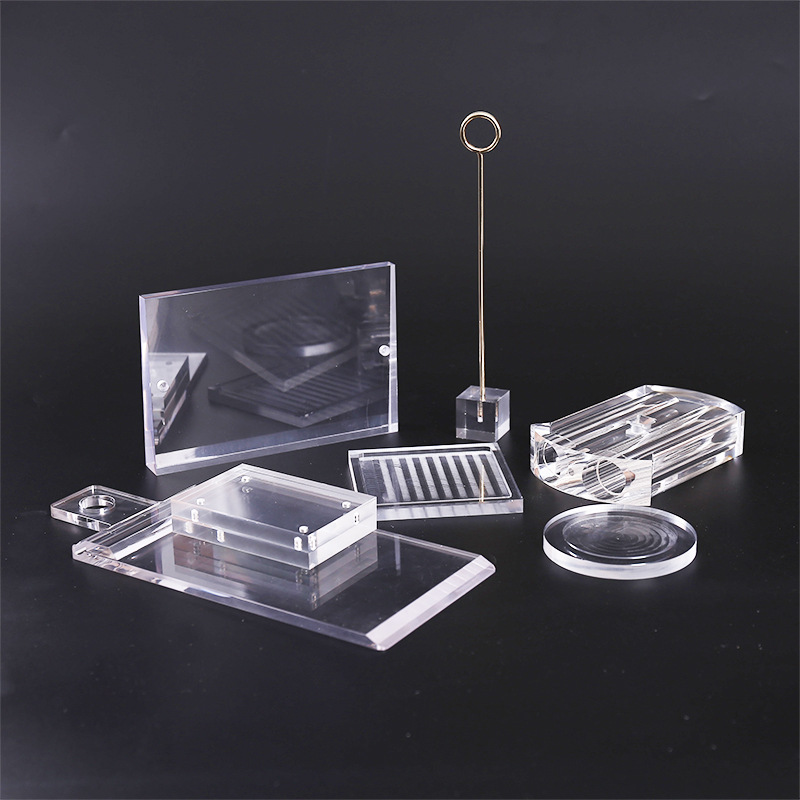We offer Acrylic CNC Solutions to meet your brand's specific goals and requirements. Our facilities are equipped with the latest technology to enable us to achieve the best results. As the leading acrylic gift items manufacturers, Lanxin company are sure to meet and exceed your expectations. If you are not sure where to start, please contact us for a free consultation.
Support ODM/OEM to meet customer's individual needs
We have our factory with years of sales and production experience
Adopt green environmental protection international brands material.Health and safety
We provide high quality customer service, please consult Lanxin ACRYLIC

For acrylic products with complex shapes, high-precision CNC processing technology is usually required to complete them. The specific process selection needs to be determined according to the complexity, precision requirements and material properties of the products. The following are several common CNC processing technologies and their applicable scenarios:
1. Five-axis CNC engraving/milling process
Features:
Multi-axis linkage: Through the linkage of three linear axes X, Y, and Z and two rotary axes (A axis, B axis or C axis), one-time processing of complex curved surfaces, multi-angle grooves, and hollow structures is achieved without multiple clamping.
High precision: Suitable for processing detailed reliefs, special-shaped curved surfaces, polyhedron splicing and other complex shapes (such as animal sculptures, art ornaments, and precision mechanical parts models).
High efficiency: Reduce manual intervention and shorten processing cycles, especially suitable for sample development before mass production.
Applicable scenarios:
Complex three-dimensional engraving: such as portraits of people, three-dimensional shapes of animals and plants, parts with spiral patterns or multi-curved surface transitions.
Precision structural parts: such as medical device accessories and complex acrylic parts in aerospace models.
2. High-speed CNC cutting process
Features:
High-speed tool: Use a milling cutter with a smaller diameter (such as 0.1~3mm) and a high-speed spindle (10,000~24,000 rpm) to achieve cutting of fine structures such as small holes, sharp angles, and narrow gaps.
Multi-level processing: Complex superimposed structures can be milled in layers (such as three-dimensional models with multiple layers of acrylic splicing, gear sets, and miniature scene props).
Good surface quality: By optimizing the feed speed and cutting depth, the edge burrs are reduced and the subsequent polishing workload is reduced.
Applicable scenarios:
Complex plane nested structures: such as multi-layer hollow window grilles, gear transmission models, circuit board slots, etc.
Micro parts processing: such as acrylic sensor housings and micro-mechanical transmission parts in precision instruments.
3. Electrospark machining (EDM) process
Features:
Non-contact machining: Using the principle of electrospark discharge corrosion, through the pulse discharge between the electrode (copper or graphite) and the acrylic material, the parts that are difficult to reach with traditional tools (such as deep and narrow grooves, inner sharp angles, and complex inner cavities) can be machined.
No mechanical stress: Avoid material deformation that may be caused by traditional milling, suitable for machining thin and brittle or easy to crack complex structures.
Applicable scenarios:
Complex inner cavity structure: such as cavity with undercut, special-shaped through hole (non-circular hole), spiral channel, etc.
High-hardness acrylic composite material: EDM processing is more advantageous for acrylic with reinforcing materials such as glass fiber.
4. Laser-assisted CNC processing technology
Features:
Compound processing: Combining the motion control of CNC machine tools with the high energy density of the laser beam to achieve "cutting + engraving" synchronous completion.
Ultra-fine processing: The diameter of the laser beam can be up to micrometer level, which is suitable for processing nano-level textures, micro-hole arrays, Fresnel lenses and other optical-level complex structures.
Small thermal impact: Short pulse lasers (such as picosecond and femtosecond lasers) are used to reduce thermal deformation and ensure high precision.
Applicable scenarios:
Optical components: such as complex curved lenses, prism arrays, micro-nano optical structures (used for VR glasses, light guide plates, etc.).
Artistic decoration: such as complex carved lampshades with high transmittance requirements and holographic projection accessories.
5. Five-axis linkage + 3D printing composite process
Features:
Additive first, then subtractive: First use 3D printing (such as light-curing SLA) to make acrylic blanks with complex shapes, and then use five-axis CNC for surface milling and precision correction, combining the advantages of both.
Complex structure molding: Suitable for processing multi-cavity and cantilever structures (such as bionic organ models and industrial robot joint parts) that are difficult to mold in one time with traditional CNC.
Applicable scenarios:
Small batch customized complex parts: such as personalized acrylic prostheses in medical devices and complex fluid pipeline models in the aerospace field.
Process selection recommendations
Evaluation complexity:
If it is a multi-curved, multi-angle hollowing, five-axis CNC milling is preferred.
If it contains deep narrow grooves and concave structures, consider EDM or laser-assisted processing.
If micron-level precision or optical surface is required, laser processing is better.
Material properties:
Ordinary acrylic (PMMA) can be selected by five-axis milling or laser cutting;
Reinforced acrylic (such as glass fiber) requires EDM or diamond tool milling.
Cost and efficiency:
When mass-producing complex parts, five-axis CNC is more efficient;
For single-piece customization or ultra-complex structures, laser/EDM machining is more flexible.
By rationally selecting CNC processes, even acrylic products with complex shapes can be processed with high precision to meet design and functional requirements.